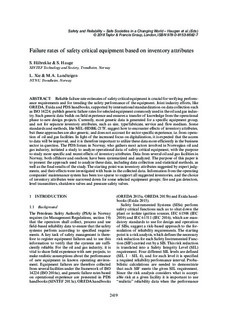| dc.description.abstract | Reliable failure rate estimates of safety critical equipment is crucial for verifying performance requirements and for trending the safety performance of the equipment. Joint industry efforts, like OREDA, Exida and PDS handbooks, supported by international standardization on data collection such as ISO 14224, publish generic failure rates for selected equipment commonly used in the oil and gas industry. Such generic data builds on field experience and ensures a transfer of knowledge from the operational phase to new design projects. Currently, most generic data is generated for a specific equipment group, and not for separate inventory attributes, such as size, type/fabricate, service and flow medium. Some standards and methods, like MIL-HDBK-217F, suggest how to encounter effects of inventory attributes, but these approaches are also generic, and does not account for sector specific experience, i.e. from operation of oil and gas facilities. In light of the increased focus on digitalization, it is expected that the access to data will be improved, and it is therefore important to utilize these data more efficiently in the business sector in question. The PDS forum in Norway, who gathers most actors involved in Norwegian oil and gas industry, initiated a study to analyze operational data of safety critical equipment, with the purpose to study more specific and recent effects of inventory attributes. Data from several oil and gas facilities in Norway, both offshore and onshore, have been systematized and analyzed. The purpose of this paper is to present the approach used to analyze these data, including data collection and statistical methods, as well as the final results of the study. The starting point was inventory attributes suggested by expert judgments, and their effects were investigated with basis in the collected data. Information from the operating companies’ maintenance system has been too sparse to support all suggested inventories, and the choice of inventory attributes were narrowed down for some selected equipment groups; fire and gas detectors, level transmitters, shutdown valves and pressure safety valves. | nb_NO |
